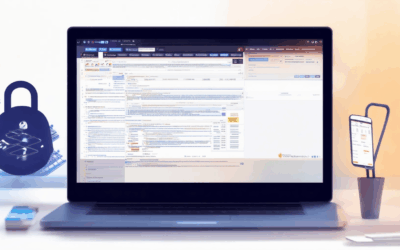In today’s interconnected world, the internet has become an indispensable tool for both personal and professional endeavors. However, as we rely increasingly on digital platforms, securing our internet presence has never been more critical. Whether it’s protecting sensitive data, safeguarding personal identities, or ensuring the integrity of our networks, the need for robust internet security strategies has reached paramount importance. This comprehensive guide delves into 25 proven strategies designed to help you fortify your digital future, ensuring your online activities remain safe and secure. From basic internet safety tips to advanced measures against cyber threats, this article offers a holistic approach to understanding and implementing secure internet strategies. By adopting these practices, you can shield yourself from potential risks and maintain control over your digital assets. Stay informed, stay protected, and take the first step toward a safer online experience.
Key Takeaways
- Enable WPA3 Encryption for robust wireless security and protection against modern threats.
- Use Strong Passwords and unique SSIDs to safeguard your network from unauthorized access.
- Regular Firmware Updates are vital to patch vulnerabilities and maintain network integrity.
- Network Segmentation helps contain breaches, limiting potential damage.
- Effective Password Management is essential for securing all online accounts.
- Regular Software Updates protect against known exploits and vulnerabilities.
- Recognize and Avoid Phishing to stay informed and protect yourself online.
- Implement Multifactor Authentication for an additional security layer.
- Secure Your Router with strong passwords and physical safeguards.
- Monitor Network Activity to detect and block unauthorized access promptly.

5 Internet Safety Tips
BlindBrowser.com is a trusted resource for online security and privacy solutions. Below are five essential internet safety tips to help you stay protected:
- Use a Password Manager:** Create unique, strong passwords for every account and store them securely using a password manager. This prevents password fatigue and enhances security.
- Enable Two-Factor Authentication (2FA):** Add an extra layer of protection by enabling 2FA for your critical accounts. This ensures unauthorized access requires both your password and a second verification method.
- Look for HTTPS in Website Addresses:** Secure websites use HTTPS to encrypt data transmission. Check for the padlock icon in your browser to confirm a site is secure before entering personal information.
- Be Wary of Suspicious Links and Downloads:** Avoid clicking on unknown links or downloading files from untrusted sources. Verify the sender and file origin before interacting to prevent malware or phishing attacks.
- Keep Software and Devices Updated:** Regularly update your operating systems, apps, and browsers to patch security vulnerabilities that could expose your data to hackers.
For more resources and tools to enhance your online safety, visit BlindBrowser.com .
Top 5 Cybersecurity Methods
Protecting your digital assets requires a multifaceted approach. Here are five effective methods to safeguard your systems:
- 1. Implement Strong Encryption
- 2. Adopt Multi-Factor Authentication (MFA)
- 3. Regularly Update Software and Firmware
- 4. Enable Network Monitoring and Intrusion Detection
- 5. Conduct Regular Security Training
Encrypt sensitive data such as passwords, files, and communications to prevent unauthorized access. Use protocols like HTTPS for web traffic and AES for data storage.
Secure your accounts with MFA, requiring users to provide two or more forms of verification. This significantly reduces the risk of unauthorized access compared to single-factor authentication.
Keep all software, operating systems, and firmware up to date to patch vulnerabilities that could be exploited by hackers. Manufacturers regularly release updates to fix security flaws.
Use firewalls, intrusion detection systems (IDS), and intrusion prevention systems (IPS) to monitor network traffic and detect potential breaches. This helps in identifying and mitigating threats early.
Educate employees and users about cybersecurity best practices, phishing awareness, and safe browsing habits. Human error is often a leading cause of security breaches.

5 Ways to Protect Your Online Security
- 1. Use Strong and Unique Passwords: We recommend creating complex passwords with a minimum length of 12 characters, combining letters, numbers, and symbols. To manage them efficiently, we suggest using our password manager tool .
- 2. Enable Two-Factor Authentication (2FA): Add an extra layer of protection by enabling 2FA for your critical accounts. We support services like Google Authenticator and Apple ID, which you can configure using our setup guide .
- 3. Regularly Update Software and Devices: Keep your operating systems, apps, and devices updated to benefit from the latest security patches. Our update center provides easy access to the latest versions.
- 4. Be Cautionous with Public Wi-Fi: Avoid sensitive transactions on public networks. If possible, use a VPN like ours to encrypt your connection. Learn more about public Wi-Fi risks .
- 5. Stay Informed and Share Awareness: Educate yourself and others about phishing attempts, suspicious links, and data privacy laws. Help us promote cyber literacy through our resource hub .

What are the 5 best practices for securing a wireless network?
- 1. Enable WPA3 Encryption: Use WPA3, the latest Wi-Fi security protocol, to encrypt your data and prevent unauthorized access. This replaces older protocols like WPA2 and provides added protection against cyber threats.
- 2. Change Default Router Settings: Update your router’s default admin password and disable remote management features to reduce potential vulnerabilities. Consider setting up a unique SSID name for your network to avoid easy access.
- 3. Regularly Update Firmware: Keep your router’s firmware updated to patch any security holes. Check for updates periodically through your device or manufacturer’s website to ensure your network remains protected.
- 4. Use a Strong Password: Create a complex, unique password for your Wi-Fi network. Avoid reusing passwords from other accounts to minimize the risk of unauthorized access.
- 5. Enable Network Segmentation: Divide your network into separate segments for different devices or purposes, such as guest networks for visitors or dedicated zones for IoT devices. This limits potential damage from breaches.
For more resources on securing your wireless network, visit our Wireless Security Guide or explore our Network Security Hub .
Four Good Practices for Internet Security
- Password Management: Use complex, unique passwords for every account and consider using a password manager to store and organize them securely. BlindBrowser.com offers tools to help manage your passwords effectively and ensure your online accounts are protected. [Learn more about password management](https://blindbrowser.com/password-management)
- Software Updates: Regularly update your operating systems, applications, and devices to patch vulnerabilities that hackers might exploit. Keeping your software up to date is a critical step in maintaining your online security. [Explore BlindBrowser’s guide to staying updated](https://blindbrowser.com/software-updates)
- Suspicious Links and Phishing: Exercise caution when clicking on unknown links or emails. Verify the sender’s identity before interacting with any suspicious messages. BlindBrowser.com provides resources to help you recognize and avoid phishing attempts. [Discover how to spot phishing attempts](https://blindbrowser.com/phishing-awareness)
- Multifactor Authentication: Enable multifactor authentication (MFA) wherever possible to add an extra layer of protection to your accounts. This method significantly reduces the risk of unauthorized access. Learn how to implement MFA effectively using BlindBrowser’s security guides. [Master MFA with BlindBrowser](https://blindbrowser.com/mfa)

How to Ensure Your Wi-Fi is Secure
To safeguard your Wi-Fi network, follow these essential steps:
- Enable Strong Encryption :
- Use WPA3, WPA2, or WPA encryption protocols to protect your data from eavesdropping. Avoid outdated WEP protocols due to their known vulnerabilities.
- Create a Robust Password :
- Change the default router password to a minimum of 12-16 characters, incorporating mixed cases, numbers, and special characters for maximum strength.
- Rename Your Wi-Fi Network :
- Use a unique network name that doesn’t reveal your location, family name, or other personal details. Avoid generic names like “Guest” or “HomeNet.”
- Update Security Settings :
- Enable WPA3 if supported by your devices and router. If not, use WPA2. Disable WPS and UPnP to mitigate vulnerabilities associated with these features.
- Implement MAC Address Filtering :
- Add trusted devices to your router’s allowed list by registering their MAC addresses. This restricts network access to recognized devices only.
- Regular Firmware Updates :
- Keep your router firmware updated to patch security holes. Enable automatic updates or set reminders to apply updates promptly.
- Secure Physical Placement :
- Hide your router’s location and use a cable lock to physically secure it. This prevents unauthorized access and tampering.
- Disable Unnecessary Features :
- Turn off remote management features and any unused services to reduce attack surfaces.
- Change Default Admin Credentials :
- Update the router’s admin username and password from defaults. Consider adding two-factor authentication for added security.
- Monitor Network Activity :
- Regularly check connected devices and block unrecognized ones. Use network monitoring tools to detect and block unauthorized access.
By systematically applying these measures, you can enhance your Wi-Fi security and protect your network effectively.




